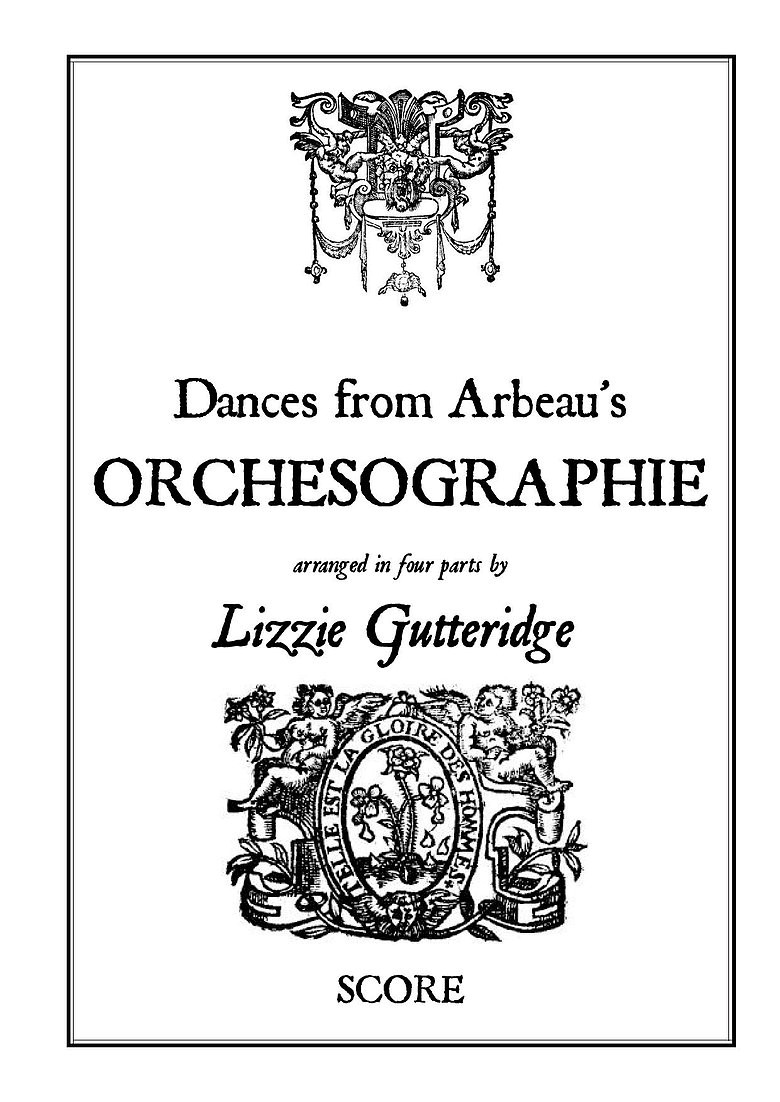The Bagpipe Society
Book Review: Dances from Arbeau’s Orchesographie Arranged by Lizzie Gutteridge

Lizzie Gutteridge is a well-known bagpiper, shawm player, and in more recent times a publisher of music in parts for shawms and for bagpipes. Just now she has fewer gigs to practise for, and has turned her attention to the wealth of music in Arbeau’s Orchesographie. All the music in Orchesographie is given as a single line, with the exception of Belle Qui Tiens Ma Vie where Arbeau gives a four-part harmony. Lizzie adopts the ‘chordal style’ of that piece for the other music and has created four-part harmonies for all the other tunes. This is no small task, and she offers us a chance to play new arrangements for these well-known tunes. You can buy a compendium of all the parts, or a print of merely the part you normally play (see below).
She has a wide audience in her sights: she says ‘Arbeau’s Orchesographie contains some of the dances most popular at Historical Dance groups, folk clubs and Medieval banquets.’ So, she is looking at an array of musicians and dancers: historical dance groups, early music players, folk musicians, folk dancers, and even classical musicians. She has in mind performers at concerts, sessions, buskers, as well as those accompanying dancing, which after all, is the aim of Orchesographie.
I have played the tunes on a variety of instruments: bagpipes, recorders, melodeon, piano, and shawms: at dance speed, as well as at a more ‘artful’ pace. Although I’ve danced many of the dances in Orchesographie, I wasn’t familiar with all the tunes. Having them laid out in one publication as Lizzie has done, alone adds value to the book.
My observations about the arrangements – and even the value of having more than a ‘top line’ - depend greatly on my focus for the piece. I am influenced inter alia by how fast I play the tune (regardless of its suitability for dancing), the necessity for the tune to drive the dance (i.e. to have in-built energy), the pulse of the music, and the artfulness of having the top line surrounded – I hesitate to say ‘swamped’ – by other parts. Some arrangements seem to work better for certain instruments. The pavans and basse dance call for shawms, the galliards for quieter woodwind, with a solo bagpipe or shawm for many of the ‘miming’ branles (Horse’s, Official’s et al) where the top line is sufficient.
As a dancer, I want to feel the beat. The tune is good to have, but rhythm is essential. Here I have a qualm: Arbeau is at pains to stress the necessary 6-beat character of the galliard – also La Volte. He says: ‘I have shown the position of the cadences by bars or perpendicular lines…’, yet Lizzie shows the Tourdion and Galliards in 3/4 time. That doesn’t fit with the pulse of the dance. La Volte, however, is shown in 6/4 time. The time signatures and bar markings for all the other tunes seem to be in accordance with Arbeau.
An unexpected bonus of having all the music written out for us is that it might prompt us to return to the original text to check our playing. Indeed, we may even need to retune our ears. I play a B flat in Jouyssance which I now know isn’t in the original, as well as a F sharp in the A and B parts of Horse’s Branle when the original shows F natural. It’s always worth going back to the original to check out your own playing.
Lizzie says that she is following the harmonic formula from Belle Qui Tiens Ma Vie in the other arrangements. However, the notes in some of her harmonies seem to drive the chordal pattern rather than following a sequence of chords indicated by the top line alone. I noticed this especially when playing the tunes and the guitar chords on my melodeon.
Looking at her guitar chords, I think that some of the best arrangements are the ones with relatively fewer guitar chord changes. The frequency of chord changes sometimes seems too great and this doesn’t enhance the driving nature of many of these tunes. One that really works for me is the First Scottish Branle where the chords and their frequency give a broody character to the piece. Yet, in the Second Branle, chords come at a frantic pace and that sense of pent-up energy is gone.
I noticed that even when the tunes are in ‘folk friendly’ keys, unusual chords sometimes intrude, and I wonder how many folk musicians are likely to play tunes in C, Gm or Dm.
So, in summary, is this book for you? Firstly, Lizzie has done us a service by putting all the music from Orchesographie into one book. Secondly, she has crafted arrangements for us to try. Finally, I’m a mongrel: I dance, teach dance, play music in concerts as well as busking. I like ‘art music’ as well as functional music. This book has enough to meet each of my interests at some point, even if it doesn’t meet them all for the whole time. I’m very glad to have it.
The book is for sale on her web shop: http://www.consortof1.co.uk/shop £12 for a score and £6 for part books in various of clefs. Copies of the Dover edition of Orchesographie (with the translation by Mary Stewart Evans and notes by Julia Sutton) are freely available online.
- Data Processing Notice (GDPR)
@BagpipeSociety on X (formally known as Twitter)
TheBagpipeSociety on Instagram
 BagpipeSociety on Facebook
BagpipeSociety on Facebook
Something wrong or missing from this page? Let us know!
